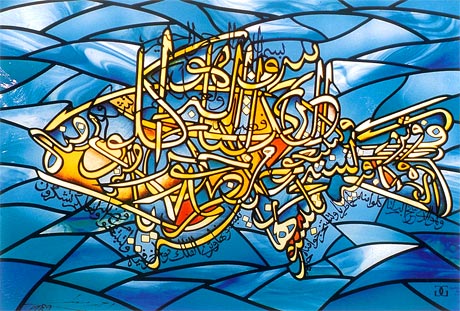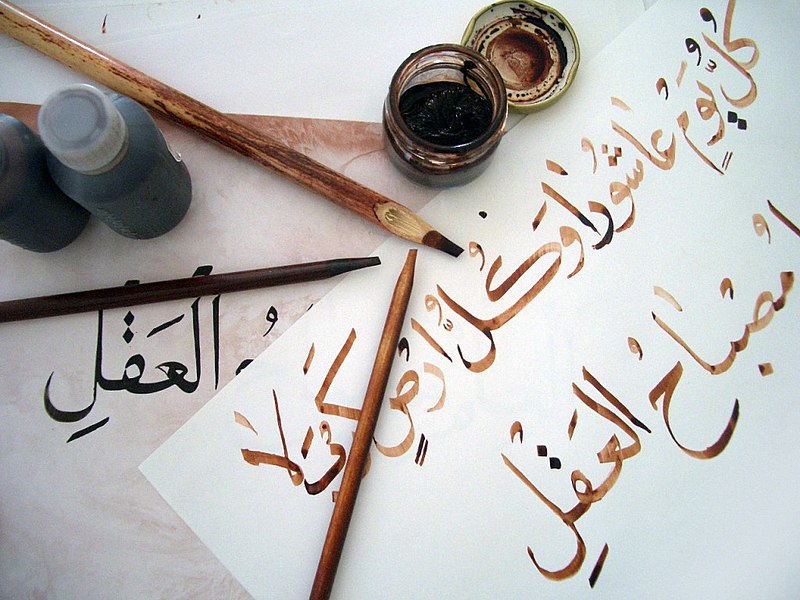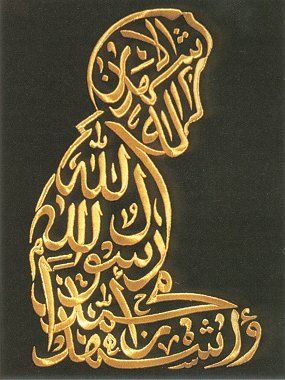Wednesday, July 16, 2008
… and they want to bomb Iran?
by Larry Geller
 I don’t think most Americans have any sense of the beauty, complexity and sophistication of the area of the world that they look upon simply as a source of oil.
I don’t think most Americans have any sense of the beauty, complexity and sophistication of the area of the world that they look upon simply as a source of oil.
Check out, for example, this recent article on one of my favorite art forms, Persian calligraphy:
Persian calligraphy: Gentle curves of beauty
Iranians have always been known for their appreciation of beauty and their artistic taste in creating masterpieces from elements. A brilliant example of such artistry is Persian calligraphy.
Ancient Persian script, which developed between 500-600 BCE, provided Achaemenid kings with magnificent monumental inscriptions. Cuneiform scripts were later replaced by 'Pahlavi' and 'Avestan' lettering.

Pahlavi script
In the 7th century BCE, the beginning of the Islamic era, Persians added four letters to the 28-letter Arabic alphabet to develop the contemporary Persian alphabet.
Considered one of the highest Islamic art forms, calligraphy soon became an indispensable part of Persian society so that it was not only practiced by professional artists but also by royalty and nobility.

Jumping forward to the Iran (and the Iranians) of today that Bush would like to bomb:
More fashion here.
A calligraphy video:
Before moving on, I must mention that Rumi was Persian. Here is his theory of evolution (from the Wikipedia):
I died as a mineral and became a plant,
I died as plant and rose to animal,
I died as animal and I was Man.
Why should I fear? When was I less by dying?
Yet once more I shall die as Man, to soar
With angels blest; but even from angelhood
I must pass on: all except God doth perish.
When I have sacrificed my angel-soul,
I shall become what no mind e'er conceived.
Oh, let me not exist! for Non-existence
Proclaims in organ tones,
'To Him we shall return.
Original Persian:
از جمادی مُردم و نامی شدم --- وز نما مُردم بحیوان سرزدم
مُردم از حیوانی و آدم شدم --- پس چه ترسم کی ز مردم کم شدم
حملهء دیگر بمیرم از بشر --- تا برآرم از ملایک بال و پر
وز ملک هم بایدم جستن ز جو --- کل شییء هالک الاوجهه
بار دیگر از ملک پران شوم --- آنچه اندر وهم ناید آن شوم
پس عدم گردم عدم چو ارغنون --- گویدم کانا الیه راجعون
Rumi's "universality"
It is often said that the teachings of Rumi are universal in nature. For him religion was mostly a personal experience and not confined to logical arguments and sense perceptions. Creative love, or the urge to rejoin the spirit to divinity, was the goal towards which every thing moves. The dignity of life, in particular human life (which is conscious of its divine origin and goal) was important.
From Persian to Arabic
Arabic calligraphy is also beautiful and an outstanding art form, practiced and developed over the millennia:

Calligraphy is of course just one cultural aspect of a civilization. When we destroyed Iraq, we trampled on and may have destroyed one of the world’s oldest and best developed cultures.
Now that Iran is in the crosshairs, I hope Americans will pay a little attention to the art, architecture, language, and of course the people of Iran. There is more to the country than the photo of its president that Bush has placed on his dart board. Look at the images above and google Iran for yourself. Remember that the bombs are directed against civilians, if they are dropped. Don’t ask me why.
But this is all disappeared news. We’re not supposed to think of the Middle East except as a source of energy. Forget I mentioned it.
Hi Larry,
I'm not sure I understand the implication of the fashion photos and your statement above them.
Is it supposed to be more alarming that that the people the US imperialists want to bomb are blond and blue-eyed?
Or is your intention to show that "they" dress like "us"?
I didn't check out the link yet, but is it your observation that Iranian fashion photography privileges blond, blue-eyed women?
If that's so, then it looks like colonalism is certainly alive and well!
Well, Katy, you could have clicked on the link before commenting. Let's see... both men and women, and only 4 out of the 15 appear to have blond hair.
If that matters to you. I didn't notice whatever their eye color was.
Instead of imputing my intent, consider that I was highlighting aspects of Iran, it's culture and modernity, that are never brought out in the MSM. Instead, the image we are fed of Iran, to dehumanize them and make it easier for Bush to bomb, is of black-robed clerics, their flaky president, and perhaps arms suppliers to anti-American forces.
Why not understand that they are human, and very much like us (whether or not they prefer blonds)? And that in fact they have a culture of their own?
I guess you missed the calligraphy in the fashion pics too.
Sorry, Larry, I think the tone of my writing sounded kind of harsh. It wasn't meant that way.
I did notice you were highlighting the calligraphy, and I do agree that it's important that we get shaken out of our US-centric view of the world, and that we humanize the populations of lands that our "leaders" talk about bombing.
I thought it was striking that the photos were of blond-haired blue-eyed women since I would imagine that such coloring is uncommon in Iran. I wondered if that was something you had picked on purpose to show that we might have a skewed understanding about the way Iranians "look." Just as it would be impossible to pick a picture of a typical "American," so perhaps, it's the same in Iran.
And I wondered what it would say about us if somehow the sight of blue-eyed blonde-haired Iranians might make us hesitate more before dropping a bomb.
I apologize again if my tone sounded accusatory, Larry.
<< Home










Post a Comment
Requiring those Captcha codes at least temporarily, in the hopes that it quells the flood of comment spam I've been receiving.